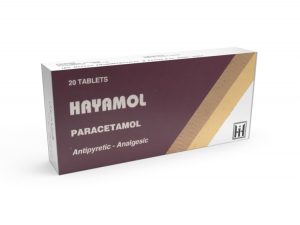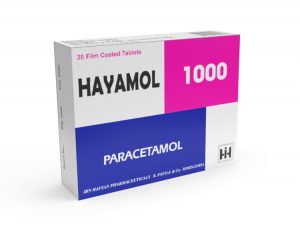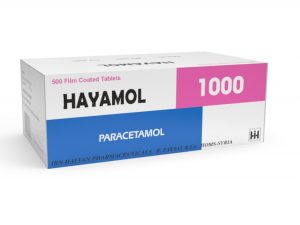
Packing :500 tab.
Form : Tablets
Theraputic Categories : Analgesics
Indications : Non-opioid analgesic and Antipyretic
Composition :Paracetamol 500 mg.
Composition and Excipients:
Each HAYAMOL 500 tablet contains:
- active ingredients: Paracetamol 500 mg.
- inactive ingredients: Povidone, Maize starch, Sodium starch glycolate, Methyl Paraben, Propyl Paraben, Magnesium stearate, Talc,and Sodium crosscarmillose.
Each HAYAMOL 1000 F.C.tablet contains:
- active ingredients: Paracetamol 1000 mg (DC).
- inactive ingredients:
Core: Magnesium stearate, Talc, and Sodium crosscarmillose.
Film: Hypromellose, Talc, Polyethylene glycol, and Titanium dioxide.
Each 5ml of HAYAMOL oral suspension contains:
- activity ingredients: Paracetamol 160 mg.
- inactive ingredients: Sorbitol 70 %, Glycerin , Aspartam, Methyl paraben, Propyl paraben, Xanthan Gum, Saccharin Sodium, D.M. Water, Red color (food grade),and Strawberry flavor
Mechanism of action:
Analgesic: Paracetamol may act by inhibiting prostaglandin synthesis in the central nervous system (CNS) and to a lesser extent, through a peripheral action by blocking pain-impulse generation.
Antipyretic: paracetamol probably produces antipyresis by acting centrally on the hypothalamic heat-regulation center to produce peripheral vasodilation resulting in increased blood flow through the skin, sweating and heat loss.
Indications:
For the treatment of mild to moderate pain including headache, migraine, neuralgia, toothache, sore throat, period pains, aches and pains, symptomatic relief of rheumatic aches and pains and of cold & influenza, fever, feverish colds and post-immunisation fever.
Contraindications:
Hypersensitivity to paracetamol or any of the constituents.
Warnings and precautions:
- In the elderly, the rate and extent of paracetamol absorption is normal but plasma half-life is longer and paracetamol clearance is lower than in adults.
- Care is advised in the administration of paracetamol to patients with severe renal or severe hepatic impairment. The hazards of overdose are greater in those with non-cirrhotic alcoholic liver disease.
- Patients should be advised that paracetamol may cause severe skin reactions. If a skin reaction such as reddening, blisters, or rash occurs or if existing skin symptoms worsen the patient should stop use and seek medical assistance right away.
- If sore throat is severe, persists for more than 2 days or is accompanied or followed by fever, headache, rash, nausea, or vomiting, the patient should consult the doctor promptly.
- The patient shouldn’t take this drug with any other paracetamol-containing product.
- If symptoms persist for more than 3 days or get worse the patient should consult the doctor.
- The patient should consult the doctor at once if he takes too much of paracetamol, this is because too much paracetamol can cause delayed, serious liver damage.
- This medicine shouldn’t be given to the child for more than 3 days without consulting to the doctor or pharmacist.
- Due to the presence of sucrose and sorbitol, patients with rare hereditary problems of fructose intolerance, glucose-galactose malabsorption or sucrase-isomaltase insufficiency should not take this medicine.
- Ethyl, Propyl and Methyl parahydroxybenzoate may cause allergic reactions
Drug Interaction:
- Cholestyramine: The speed of absorption of paracetamol is reduced by cholestyramine. Therefore, it shouldn’t be taken within one hour if maximal analgesia is required.
- Metoclopramide and Domperidone: The absorption of paracetamol is increased by metoclopramide and domperidone.
- Warfarin: The anticoagulant effect of warfarin and other coumarins may be enhanced by prolonged regular use of paracetamol with increased risk of bleeding; occasional doses have no significant effect.
- Chloramphenicol: Increased plasma concentration of chloramphenicol.
- Antivirals: Regular use of Paracetamol possibly reduces metabolism of Zidovudine (increased risk of neutropenia).
- Patients who have taken barbiturates, tricyclic antidepressants and alcohol may show diminished ability to metabolise large doses of paracetamol, the plasma half-life of which can be prolonged.
- Chronic alcohol intake can increase the hepatotoxicity of paracetamol overdose and may have contributed to the acute pancreatitis reported in one patient who had taken an overdose of paracetamol.
- The use of drugs that induce hepatic microsomal enzymes, such as anticonvulsants and oral contraceptives, may increase the extent of metabolism of paracetamol, resulting in reduced plasma concentrations and a faster elimination rate
Pregnancy and lactation:
Studies in human pregnancy have shown no ill effects due to paracetamol used in the recommended dosage, but patients should follow the advice of the doctor regarding its use.
Paracetamol is excreted in breast milk but not in a clinically significant amount. Available data do not contraindicate breast feeding.
Undesirable effects:
- Adverse effects of paracetamol are rare. Very rarely hypersensitivity and anaphylactic reactions including skin rash may occur. Very rare cases of serious skin reactions have been reported.
- There have been reports of blood dyscrasias including thrombocytopenia and agranulocytosis, but these were not causally related to paracetamol.
- Chronic hepatic necrosis has been reported in a patient who took daily therapeutic doses of paracetamol for about a year and liver damage has been reported after daily ingestion of excessive amounts for shorter periods.
- Nephrotoxicity following therapeutic doses of paracetamol is uncommon.
- Papillary necrosis has been reported after prolonged administration.
- Low level transaminase elevations may occur in some patients taking therapeutic doses of paracetamol; these are not accompanied with liver failure and usually resolve with continued therapy or discontinuation of paracetamol.
Dosage and method of administration:
For (500 mg or 1000 mg tab, Fct):
- Adults, the elderly and over 12 years: 2 tablets 500 mg or 1 tab 1000 mg, every 4 hours to a maximum of 8 tablets for 500 mg and 4 for 1000 mg tablets in 24 hours.
- Children 6 – 12 years: ½ to 1 tablet (500 mg) every 4 hours to a maximum of 4 tablets in 24 hours.
- Under 6 years of age: shouldn’t be given.
For 250 mg / 5ml Suspension
- Children under 6 years of age: shouldn’t be given.
- Children aged 6 to 12 years:
- 6-8 years: 5 ml 4 times daily.
- 8-10 years: 7.5 ml 4 times daily
- 10-12 years: 10 ml 4 times daily
Do not give more than 4 doses in any 24 hour period, Leave at least 4 hours between doses.
- Children aged 12-16 years: 10-15 ml up to 4 times a day.
- Adults and children over 16 years: 10-20 ml up to 4 times a day.
For 160 mg/5ml Suspension:
- Children from 2-3 years of age : 5 mL every 4 hours while symptoms last , do not give more than 5 times in 24 hours
- Less than 2 years: ask a doctor.
For 120 mg / 5ml Suspension:
- For the relief of fever after vaccinations at age (2, 3 and 4 months):5 ml may be given up to 4 times a day starting at the time of vaccination, Do not give more than 4 doses in any 24 hour period, Leave at least 4 hours between doses, If the baby still needs this medicine two days after receiving the vaccine talk to the doctor.
- For Pain and other causes of fever:
Babies less than 2 months of age: shouldn’t be given.
Age ( 2 – 3 ) months: if the baby weighs over 4 kg and was born after 37 weeks: 2.5 ml If necessary, after 4-6 hours, give a second 2.5 ml dose, Leave at least 4 hours between doses. Do not give more than 2 doses. This is to ensure that fever that may be due to a serious infection is quickly diagnosed. If the child is still feverish after two doses, talk to the doctor or pharmacist.
Children aged 3 months – 6 years
Age 3 months – 6 months: 2.5 ml 4 times daily
Age 6 – 24 months: 5 ml 4 times daily
Age 2 – 4 years: 7.5 ml 4 times daily
Age 4 – 6 years: 10 ml 4 times daily
Do not give more than 4 doses in any 24 hour period, Leave at least 4 hours between doses.
Overdosage:
Liver damage is possible in adults who have taken 10g or more of paracetamol. Ingestion of 5g or more of paracetamol may lead to liver damage if the patient has risk factors: If the patient is on long term treatment drugs that induce liver enzymes or regularly consumes ethanol in excess amount or if the patient is glutathione depleted.
Symptoms: Symptoms of paracetamol overdosage in the first 24 hours are pallor, nausea, vomiting, anorexia and abdominal pain. Liver damage may become apparent 12 to 48 hours after ingestion.
Treatment: Immediate treatment is essential in the management of paracetamol overdose.
Treatment with activated charcoal should be considered if the overdose has been taken within 1 hour. Treatment with N-acetylcysteine may be used up to 24 hours after ingestion of paracetamol.
Storage:
Tablets: Don’t store above 25 C°.
Suspension: Store at a temperature below 25 C°. Protect from light. Don’t freeze.
Packing:
Tablets: A box contains 20 or 500 tablets.
Oral suspension: A bottle 60 or 100 ml.












